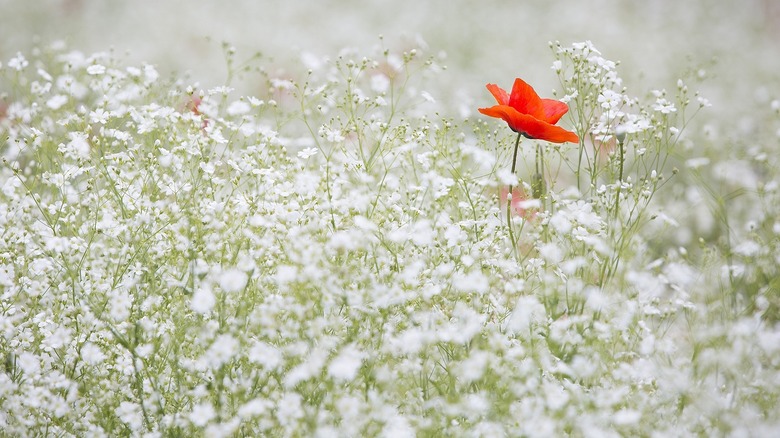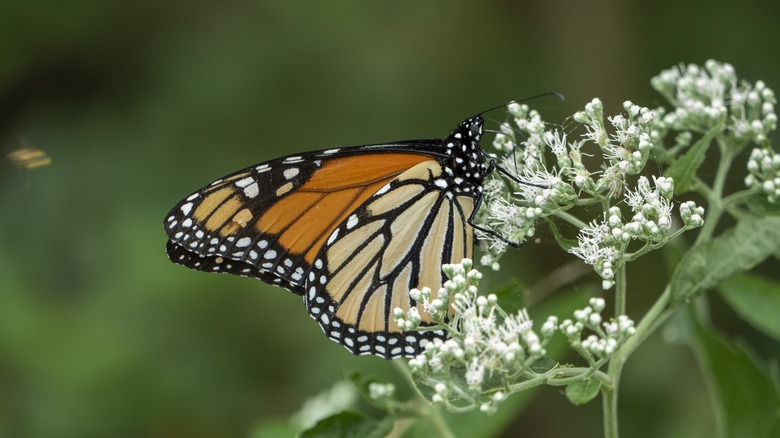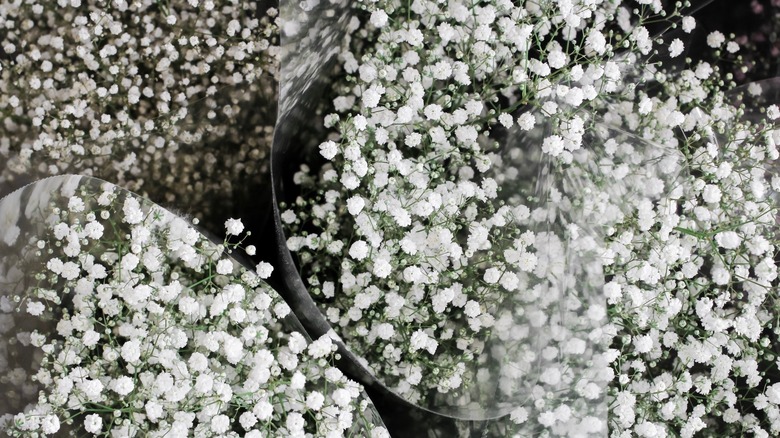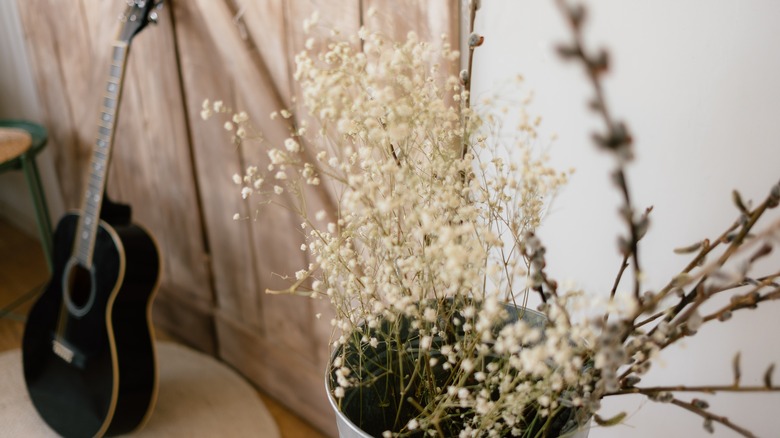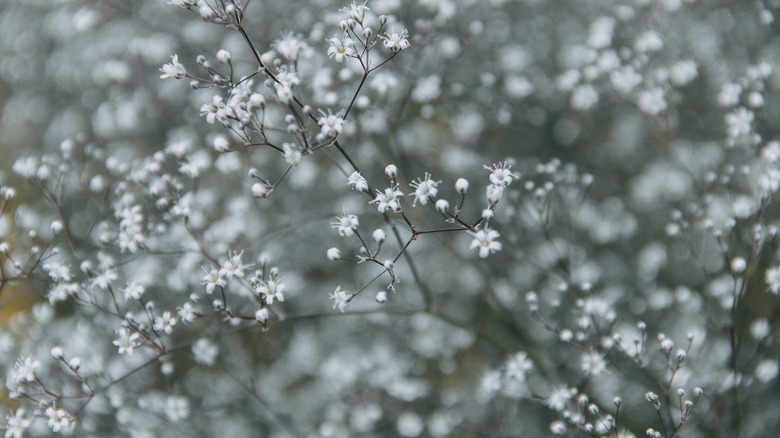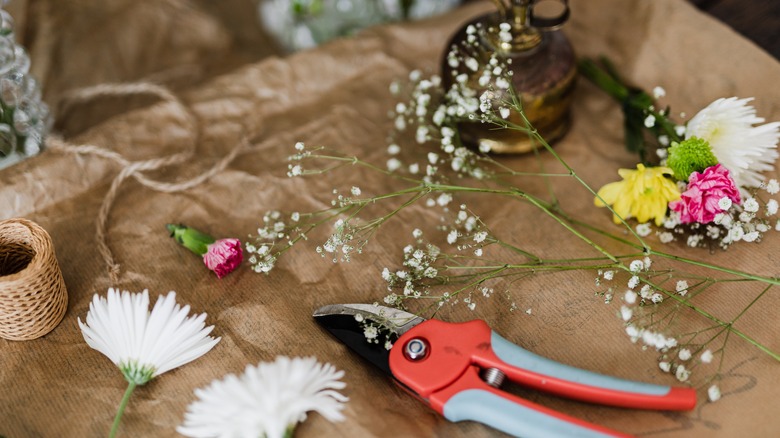How To Grow And Take Care Of Baby's Breath
Baby's breath, also known as the gypsophila genus, are gorgeous, delicate flowers, most commonly used in floral arrangements. In flower language, baby's breath represents eternal love, according to The Spruce. Florgeous said this flower is also a common wedding flower due to its romantic meaning and its sweet smell and appearance. They also say that giving baby's breath as a wedding gift symbolizes the couple having lots of children.
Native to Africa, Asia, Australia, and Europe, this quick-growing flower is often recognized for its petite white buds, but it can also be grown in shades of pink, per The Spruce. These easy-to-care-for flowers can be grown in an array of ways depending on the variety, including ground cover or in bushes.
Baby's breath is a romantic, low-maintenance flower. They are a great option to add a touch of charm to your garden, and cut flowers can be added to a floral arrangement or displayed by themselves for a gorgeous, elegant decoration.
How to use baby's breath in garden
Baby's breaths can add a romantic touch to any backyard or garden and will provide an abundance of harvestable flowers. Before planting the flowers in your garden, make sure you live in hardiness zones 3 through 9, warned SFGate. Also, ensure baby's breaths are not considered invasive where you live, such as in Northwest Michigan (via Habitat Matters).
According to The Spruce, baby's breath flowers are also commonly pollinated by butterflies, and their presence in your garden should attract them. They also don't attract many pests naturally and, as such, can be planted near other plants that could benefit from butterfly pollination. Baby's breath has a taproot system, per HGTV, and should not be moved once planted.
Baby's breath also produces a strong fragrance. While this is a benefit of the plant for many gardeners, it can also be overwhelming. Keep this in mind when planting — if you enjoy the scent, plant it somewhere close to the more frequented areas of your garden, and if it upsets you, keep it away from heavily trafficked spots. Baby's breaths can be grown as either ground cover or small shrubs, depending on the variety. Both of these options will produce a fantasy-like quality to your yard or garden — one producing sprawling, dreamy patches of the delicate pink or white flowers, the other offering a more concise but eye-catching option.
How to grow baby's breath
Growing baby's breath from seed is the easiest way to get the plant in your garden. Due to the taproot system, it is unlikely that the roots will produce offshoots, and disturbing the plant to check will cause more harm than good. When growing from seed, make sure you select a perennial variety so your hard work isn't wasted once the season ends.
Gardening Know How says the quickest way to achieve germination is to sew the seeds directly into the ground in weather that consistently remains 70 degrees, such as spring after the threat of frost has passed. When planting in the ground, ensure that the soil is more alkaline, and break up as much clay as possible. Ensure the soil is well-draining. Baby's breath like plenty of direct sun, according to SFGate, so keep this in mind when deciding where to plant. Till the soil, and add seeds to the surface. Ensure there are at least 9 inches between each seed — cover with a 1/4 inch more of soil, then water. Make sure the growth is not crowded and keep moist but not soggy or waterlogged. Flowers may start blooming within the year, but they can also take a few growing seasons. This may be due to too much clay or too acidic soil.
How to care for baby's breath
Caring for baby's breath is an easy process. Once mature, the plant is quite self-sustaining, as long as it receives ample light and alkaline soil. According to SFGate, baby's breath should receive at least six hours of direct sunlight. They recommend watering heavily once every two to three weeks. Regular rain conditions should provide an adequate water supply, but check to ensure the soil is consistently moist. The plant will do better in drier soil than soggy, so be a little conservative when watering. Due to its taproot system, it can be drought-tolerant but will not enjoy being waterlogged.
Fertilize baby's breath once a month during the spring through fall, stopping just before the first frost. Consider a 10-10-10 formula fertilizer. Check your soil regularly with a pH meter to ensure the plant is in alkaline soil. According to HGTV, the flower's scientific name translates to lime-loving due to its alkaline preference. As the translation suggests, you can amend acidic soil with garden lime.
Mature plants may need stakes to support the weight of their growth. Consider placing wire mesh around the barrier of the plant to prevent interest from wildlife, such as gophers, or copper to prevent slugs and snails. Various repellents are sold in garden supply stores to help with prevention and treatment, such as sprays, granules, and gopher repellent stakes.
Potted baby's breath
The biggest issue when growing baby's breath is the soil's clay content. While using various soil amendments or organic matter is usually enough to support the plant, certain regions have such clay-rich dirt that sustaining a baby's breath plant will be difficult, if not impossible. Keeping a potted baby's breath is an ideal solution to this. Potting baby's breath is also a great alternative if you live somewhere where the flower is considered invasive.
According to Gardening Know How, baby's breath will do best in well-draining soil, just as in the ground. They also recommend adding coarse sand, perlite, vermiculite, or pumice to the soil. To sew the seeds, simply sprinkle them on top and cover lightly with more soil or sand, mist daily, and expect germination within a few weeks. Care for them as usual — lots of sun, water when dry, and fertilize during their growing season.
Baby's breath varieties
According to Britannica, there are over 150 species of the Gypsophila genus. They all range in size and color, some perennial varieties sporting blooms every year, and some that are just annuals. Here are just a few of those varieties, per Home Stratosphere:
- Million star — This perennial variety is one of the more standard baby's breaths, with cottony, cloud-like flowers.
- Pink fairy — As per the name, this perennial variety of baby's breath is easily identifiable by its lush pink flowers and only grows up to 18 inches.
- Viette's dwarf — Another pink perennial, this variety only grows up to 15 inches.
- Compacta plena — This variety is another perennial; its white flowers sometimes sport pink edges and grow up to 2 feet.
- Showy baby's breath — This is the annual variety of baby's breath, also known as maiden's breath. While it will die off every winter, it will also spread itself by seed and come back yearly with new plants (via North Carolina State University).
Is baby's breath toxic?
According to the ASPCA, baby's breaths are non-toxic to cats, dogs, and horses — ingestion should not be encouraged, though, since it can lead to an upset stomach or diarrhea. Gardening Know How also warns these flowers are uniquely upsetting to cats and can cause a lack of energy, loss of appetite, and depression. Baby's breath contains gyposenin, which leads to a disturbance in the gastrointestinal system. Wag also says gyposenin is mildly upsetting to dogs but warns that it can be more dangerous when consumed by older or immunocompromised canines in large amounts. While the consumption of baby's breath will not likely result in a trip to the vet, keep pets away from the plant indoors or out.
While baby's breath is not poisonous for humans, Gardening Know How also warns that it can cause contact dermatitis and rashes. This is not the case for everyone, but you should still avoid overhandling the plant. Make sure to wash your hands after handling, and consider wearing gardening gloves if you're particularly sensitive. If the rash doesn't go away or gets worse, consult a doctor. They also warn that, as with all flowers, exposure to baby's breath can trigger an allergy flare-up.
